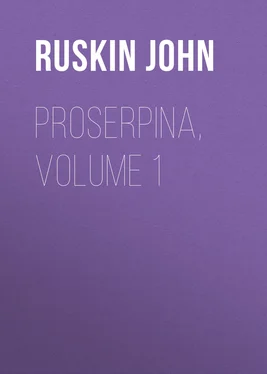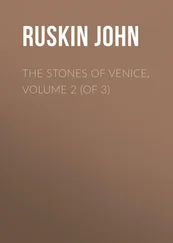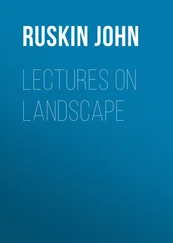John Ruskin - Proserpina, Volume 1
Здесь есть возможность читать онлайн «John Ruskin - Proserpina, Volume 1» — ознакомительный отрывок электронной книги совершенно бесплатно, а после прочтения отрывка купить полную версию. В некоторых случаях можно слушать аудио, скачать через торрент в формате fb2 и присутствует краткое содержание. Жанр: foreign_antique, Биология, literature_19, foreign_edu, на английском языке. Описание произведения, (предисловие) а так же отзывы посетителей доступны на портале библиотеки ЛибКат.
- Название:Proserpina, Volume 1
- Автор:
- Жанр:
- Год:неизвестен
- ISBN:нет данных
- Рейтинг книги:3 / 5. Голосов: 1
-
Избранное:Добавить в избранное
- Отзывы:
-
Ваша оценка:
- 60
- 1
- 2
- 3
- 4
- 5
Proserpina, Volume 1: краткое содержание, описание и аннотация
Предлагаем к чтению аннотацию, описание, краткое содержание или предисловие (зависит от того, что написал сам автор книги «Proserpina, Volume 1»). Если вы не нашли необходимую информацию о книге — напишите в комментариях, мы постараемся отыскать её.
Proserpina, Volume 1 — читать онлайн ознакомительный отрывок
Ниже представлен текст книги, разбитый по страницам. Система сохранения места последней прочитанной страницы, позволяет с удобством читать онлайн бесплатно книгу «Proserpina, Volume 1», без необходимости каждый раз заново искать на чём Вы остановились. Поставьте закладку, и сможете в любой момент перейти на страницу, на которой закончили чтение.
Интервал:
Закладка:
8. Secondly; think awhile of its dark clear green, and the good of it to you. Scientifically, you know green in leaves is owing to 'chlorophyll,' or, in English, to 'greenleaf.' It may be very fine to know that; but my advice to you, on the whole, is to rest content with the general fact that leaves are green when they do not grow in or near smoky towns; and not by any means to rest content with the fact that very soon there will not be a green leaf in England, but only greenish-black ones. And thereon resolve that you will yourself endeavour to promote the growing of the green wood, rather than of the black.
9. Looking at the back of your laurel-leaves, you see how the central rib or spine of each, and the lateral branchings, strengthen and carry it. I find much confused use, in botanical works, of the words Vein and Rib. For, indeed, there are veins in the ribs of leaves, as marrow in bones; and the projecting bars often gradually depress themselves into a transparent net of rivers. But the mechanical force of the framework in carrying the leaf-tissue is the point first to be noticed; it is that which admits, regulates, or restrains the visible motions of the leaf; while the system of circulation can only be studied through the microscope. But the ribbed leaf bears itself to the wind, as the webbed foot of a bird does to the water, and needs the same kind, though not the same strength, of support; and its ribs always are partly therefore constituted of strong woody substance, which is knit out of the tissue; and you can extricate this skeleton framework, and keep it, after the leaf-tissue is dissolved. So I shall henceforward speak simply of the leaf and its ribs,—only specifying the additional veined structure on necessary occasions.
10. I have just said that the ribs—and might have said, farther, the stalk that sustains them—are knit out of the tissue of the leaf. But what is the leaf tissue itself knit out of? One would think that was nearly the first thing to be discovered, or at least to be thought of, concerning plants,—namely, how and of what they are made. We say they 'grow.' But you know that they can't grow out of nothing;—this solid wood and rich tracery must be made out of some previously existing substance. What is the substance?—and how is it woven into leaves.—twisted into wood?
11. Consider how fast this is done, in spring. You walk in February over a slippery field, where, through hoar-frost and mud, you perhaps hardly see the small green blades of trampled turf. In twelve weeks you wade through the same field up to your knees in fresh grass; and in a week or two more, you mow two or three solid haystacks off it. In winter you walk by your currant-bush, or your vine. They are shrivelled sticks—like bits of black tea in the canister. You pass again in May, and the currant-bush looks like a young sycamore tree; and the vine is a bower: and meanwhile the forests, all over this side of the round world, have grown their foot or two in height, with new leaves—so much deeper, so much denser than they were. Where has it all come from? Cut off the fresh shoots from a single branch of any tree in May. Weigh them; and then consider that so much weight has been added to every such living branch, everywhere, this side the equator, within the last two months. What is all that made of?
12. Well, this much the botanists really know, and tell us,—It is made chiefly of the breath of animals: that is to say, of the substance which, during the past year, animals have breathed into the air; and which, if they went on breathing, and their breath were not made into trees, would poison them, or rather suffocate them, as people are suffocated in uncleansed pits, and dogs in the Grotta del Cane. So that you may look upon the grass and forests of the earth as a kind of green hoar-frost, frozen upon it from our breath, as, on the window-panes, the white arborescence of ice.
13. But how is it made into wood?
The substances that have been breathed into the air are charcoal, with oxygen and hydrogen,—or, more plainly, charcoal and water. Some necessary earths,—in smaller quantity, but absolutely essential,—the trees get from the ground; but, I believe all the charcoal they want, and most of the water, from the air. Now the question is, where and how do they take it in, and digest it into wood?
14. You know, in spring, and partly through all the year, except in frost, a liquid called 'sap' circulates in trees, of which the nature, one should have thought, might have been ascertained by mankind in the six thousand years they have been cutting wood. Under the impression always that it had been ascertained, and that I could at any time know all about it, I have put off till to-day, 19th October, 1869, when I am past fifty, the knowing anything about it at all. But I will really endeavour now to ascertain something, and take to my botanical books, accordingly, in due order.
(1) Dresser's "Rudiments of Botany." 'Sap' not in the index; only Samara, and Sarcocarp,—about neither of which I feel the smallest curiosity. (2) Figuier's "Histoire des Plantes." 18 18 An excellent book, nevertheless.
'Sêve,' not in index; only Serpolet, and Sherardia arvensis, which also have no help in them for me. (3) Balfour's "Manual of Botany." 'Sap,'—yes, at last. "Article 257. Course of fluids in exogenous stems." I don't care about the course just now: I want to know where the fluids come from. "If a plant be plunged into a weak solution of acetate of lead,"—I don't in the least want to know what happens. "From the minuteness of the tissue, it is not easy to determine the vessels through which the sap moves." Who said it was? If it had been easy, I should have done it myself. "Changes take place in the composition of the sap in its upward course." I dare say; but I don't know yet what its composition is before it begins going up. "The Elaborated Sap by Mr. Schultz has been called 'latex.'" I wish Mr. Schultz were in a hogshead of it, with the top on. "On account of these movements in the latex, the laticiferous vessels have been denominated cinenchymatous." I do not venture to print the expressions which I here mentally make use of.
15. Stay,—here, at last, in Article 264, is something to the purpose: "It appears then that, in the case of Exogenous plants, the fluid matter in the soil, containing different substances in solution, is sucked up by the extremities of the roots." Yes, but how of the pine trees on yonder rock?—Is there any sap in the rock, or water either? The moisture must be seized during actual rain on the root, or stored up from the snow; stored up, any way, in a tranquil, not actively sappy, state, till the time comes for its change, of which there is no account here.
16. I have only one chance left now. Lindley's "Introduction to Botany." 'Sap,'—yes,—'General motion of.' II. 325. "The course which is taken by the sap, after entering a plant, is the first subject for consideration." My dear doctor, I have learned nearly whatever I know of plant structure from you, and am grateful; and that it is little, is not your fault, but mine. But this—let me say it with all sincere respect—is not what you should have told me here. You know, far better than I, that 'sap' never does enter a plant at all; but only salt, or earth and water, and that the roots alone could not make it; and that, therefore, the course of it must be, in great part, the result or process of the actual making. But I will read now, patiently; for I know you will tell me much that is worth hearing, though not perhaps what I want.
Yes; now that I have read Lindley's statement carefully, I find it is full of precious things; and this is what, with thinking over it, I can gather for you.
17. First, towards the end of January,—as the light enlarges, and the trees revive from their rest,—there is a general liquefaction of the blood of St. Januarius in their stems; and I suppose there is really a great deal of moisture rapidly absorbed from the earth in most cases; and that this absorption is a great help to the sun in drying the winter's damp out of it for us: then, with that strange vital power,—which scientific people are usually as afraid of naming as common people are afraid of naming Death,—the tree gives the gathered earth and water a changed existence; and to this new-born liquid an upward motion from the earth, as our blood has from the heart; for the life of the tree is out of the earth; and this upward motion has a mechanical power in pushing on the growth. " Forced onward by the current of sap, the plumule ascends," (Lindley, p. 132,)—this blood of the tree having to supply, exactly as our own blood has, not only the forming powers of substance, but a continual evaporation, "approximately seventeen times more than that of the human body," while the force of motion in the sap "is sometimes five times greater than that which impels the blood in the crural artery of the horse."
Читать дальшеИнтервал:
Закладка:
Похожие книги на «Proserpina, Volume 1»
Представляем Вашему вниманию похожие книги на «Proserpina, Volume 1» списком для выбора. Мы отобрали схожую по названию и смыслу литературу в надежде предоставить читателям больше вариантов отыскать новые, интересные, ещё непрочитанные произведения.
Обсуждение, отзывы о книге «Proserpina, Volume 1» и просто собственные мнения читателей. Оставьте ваши комментарии, напишите, что Вы думаете о произведении, его смысле или главных героях. Укажите что конкретно понравилось, а что нет, и почему Вы так считаете.












